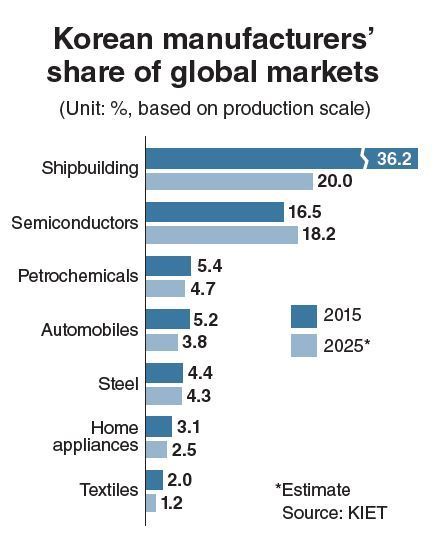Korea’s manufacturing industries have been losing their vitality, squeezed between worsening external conditions and domestic policies that are an increasing burden on them.
Industrial facilities across the country ran at 71.6 percent of their capacities on average in the second quarter of this year, according to Statistics Korea.
The figure is the lowest since the January-March period of 2009 when the Korean economy was struggling to pull out of the aftermath of a global financial crisis.
Barring the manufacturing sector, which has been in a record boom since last year, the average operation rate is much lower, analysts say.
Local shipyards, for instance, operated at 67.6 percent of their capacities in the second quarter.
The high-performing semiconductor sector has made an overwhelming contribution to boosting the country’s exports and corporate profits as a whole, veiling the sluggishness of other manufacturing industries.
About 650 listed companies in Korea earned 78 trillion won ($69.2 billion) in operating profits in the first half of the year, an increase of 12 trillion won from the same period last year, according to data from the Korea Exchange.
Excluding Samsung Electronics and SK hynix, the country’s two semiconductor manufacturers, the figure for the rest of the listed firms decreased by 2 trillion won to 48 trillion won.
In particular, Hyundai Motor, Korea’s largest carmaker, saw its operating profits fall by 16.5 percent to 2.59 trillion won, with its sales in China nearly halved.
Samsung Electronics and SK hynix accounted for 38 percent of operating profits earned by all listed firms in the six months through June, up from 24 percent a year earlier.
Korea recorded a trade surplus of $45.8 billion in the first half of 2017. But the figure is reduced to $21.6 billion, if the semiconductor sector is excluded.
In the cited period, the country saw a reduction in the shipment of other major export items, including smartphones and home appliances.
“The first-half trade surplus would have decreased by 14 percent from the year before, if semiconductor exports remained at the same level,” said Kim Go-hyun, an analyst at the Institute for International Trade, a research arm of the Korea International Trade Association.
Most exporting manufacturers in the country are struggling to maintain their competitiveness amid worsening external conditions, including growing pressure from the world’s two largest economies.
China is intensifying economic retaliation against Seoul’s hosting of a US missile defense system and the US is pushing to revise a bilateral free trade accord with Korea.
Research organizations predict the boom cycle of semiconductors in global demand may be over in a couple of years, exposing the vulnerability of the Korean economy.
Economists say the government now needs to implement policies focused on boosting corporate competitiveness and accelerating the shift to new industries.
But President Moon Jae-in’s administration and ruling party lawmakers have pushed for measures that will put a heavier burden on companies.
Business circles worry that minimum wage increases and reduced working hours will lead to a sharp rise in labor costs, which many small businesses might not be able to keep up with.
The plans to raise corporate tax rates and phase out nuclear power generation possibly at the expense of higher electricity rates would also result in further increasing corporate costs.
More worrisome is the lack of relevant industrial policies and regulatory reforms, which could ensure the long-term growth of the economy, experts say.
Kang Sung-jin, a professor of economics at Korea University, said corporate restructuring and technological innovation should be accelerated for the country to move beyond the stalemate faced by most manufacturing industries over the years.
According to data from the Ministry of Trade, Industry and Energy, there has been no change in Korea’s 13 major export items for the past decade. Their proportion of the country’s total overseas shipments has hovered around 80 percent.
A report from the Korea Institute for Industrial Economics and Trade, a state-funded think tank, predicted the global market shares of the key export items would continue to shrink in the years to come.
The figures for ships, petrochemical products and cars were projected to fall from 36.2 percent, 5.4 percent and 5.2 percent in 2015 to 20 percent, 4.7 percent and 3.8 percent in 2025, respectively.
Korean manufacturers in the fields of steel, home appliances and textiles are also forecast to see their world market shares decline from 4.4 percent, 3.1 percent and 2 percent to 4.3 percent, 2.5 percent and 1.2 percent, respectively, over the cited period.
Only chipmakers are expected to increase their shares from 16.5 percent to 18.2 percent.
Sung Tae-yoon, a professor of economics at Yonsei University, noted the number of Korean companies with a technological competitive edge has been decreasing.
“Companies need to concentrate their research and development investment in specific areas, in which they can go ahead,” he said.
Coherent policies and regulatory reforms are all the more needed to develop future growth engines in keeping with a new wave of industrial changes.
In response to criticism that it has so far tilted toward expanding welfare benefits, the Moon administration is scheduled to announce a set of measures aimed at promoting what it describes as innovative growth.
Experts note the shrinking workforce should be taken into account as a key factor in working out long-term industrial policies to bolster the country’s growth potential.
The number of people aged 15-64, which stood at 37.63 million in 2016, is expected to begin declining this year, shrinking to about 20 million by 2065, according to estimates by the Bank of Korea.
By Kim Kyung-ho ([email protected])


